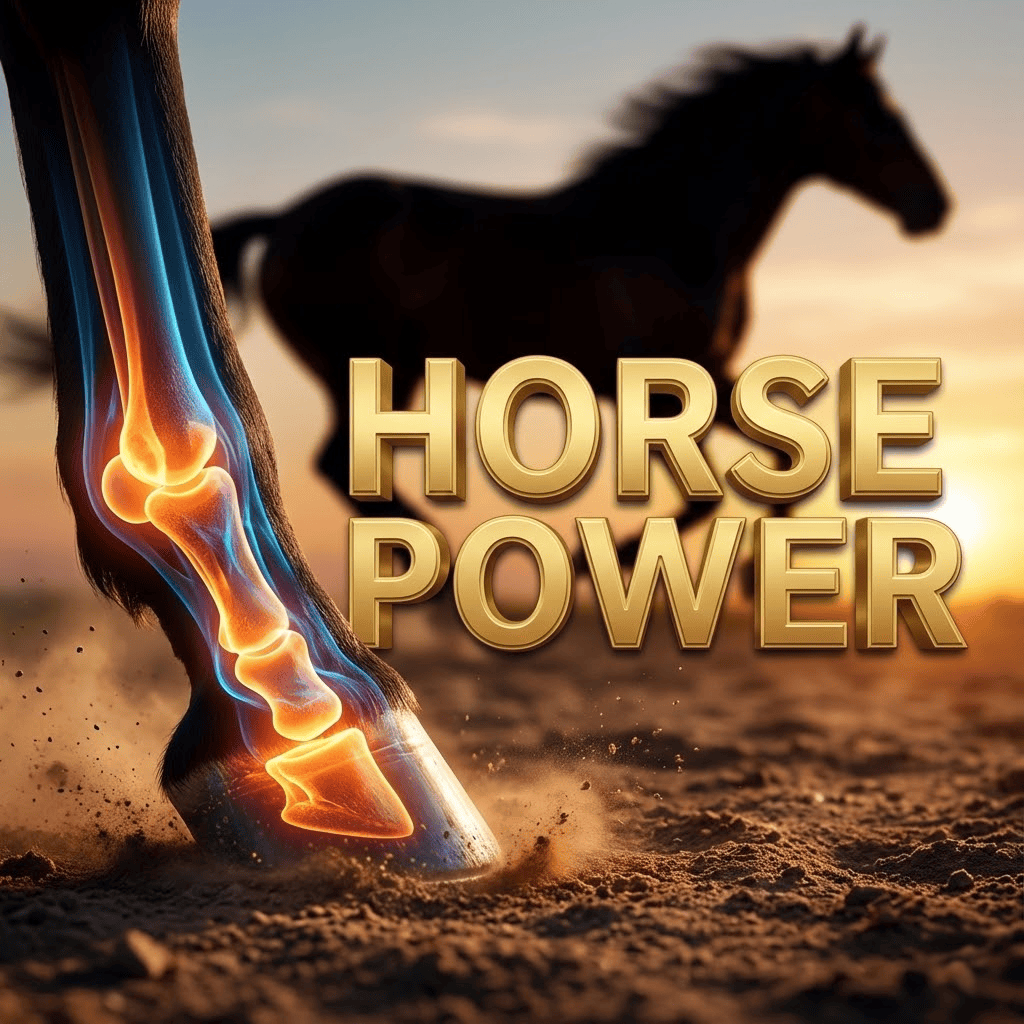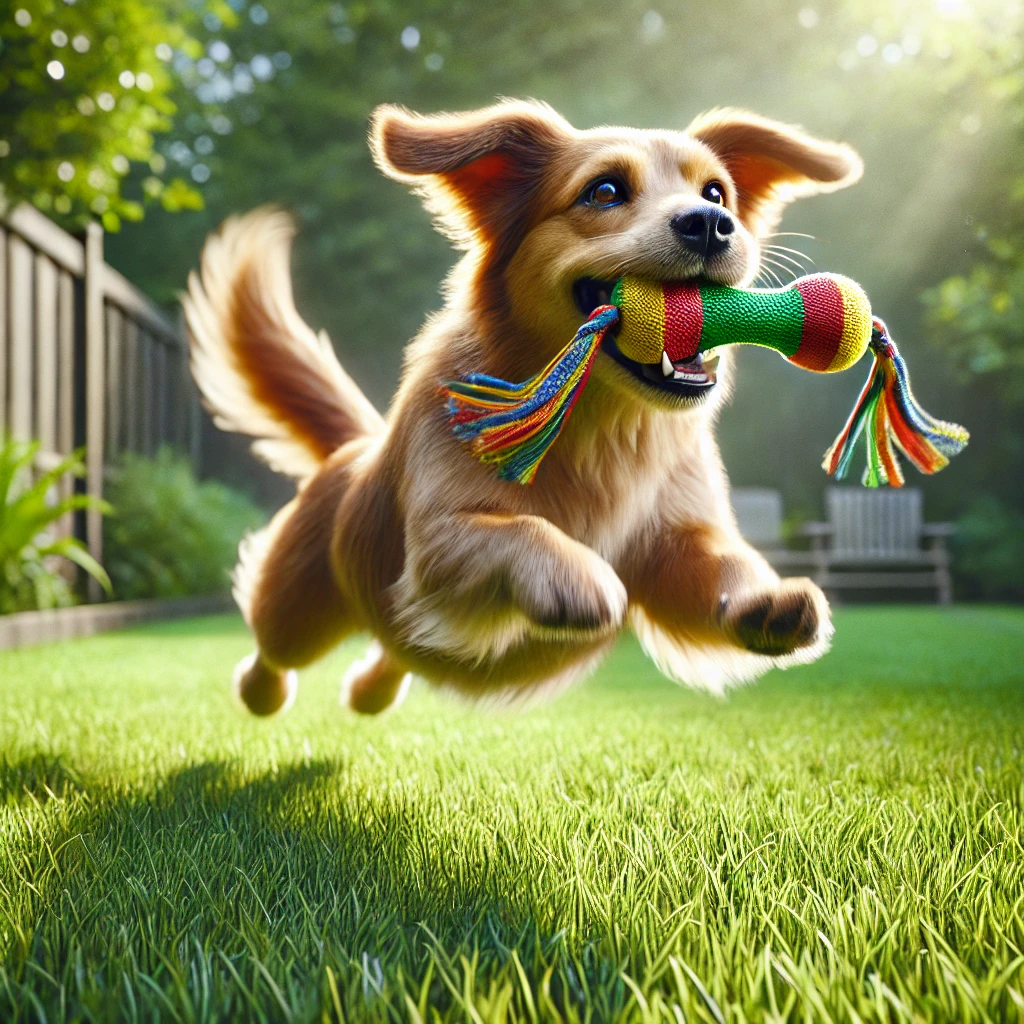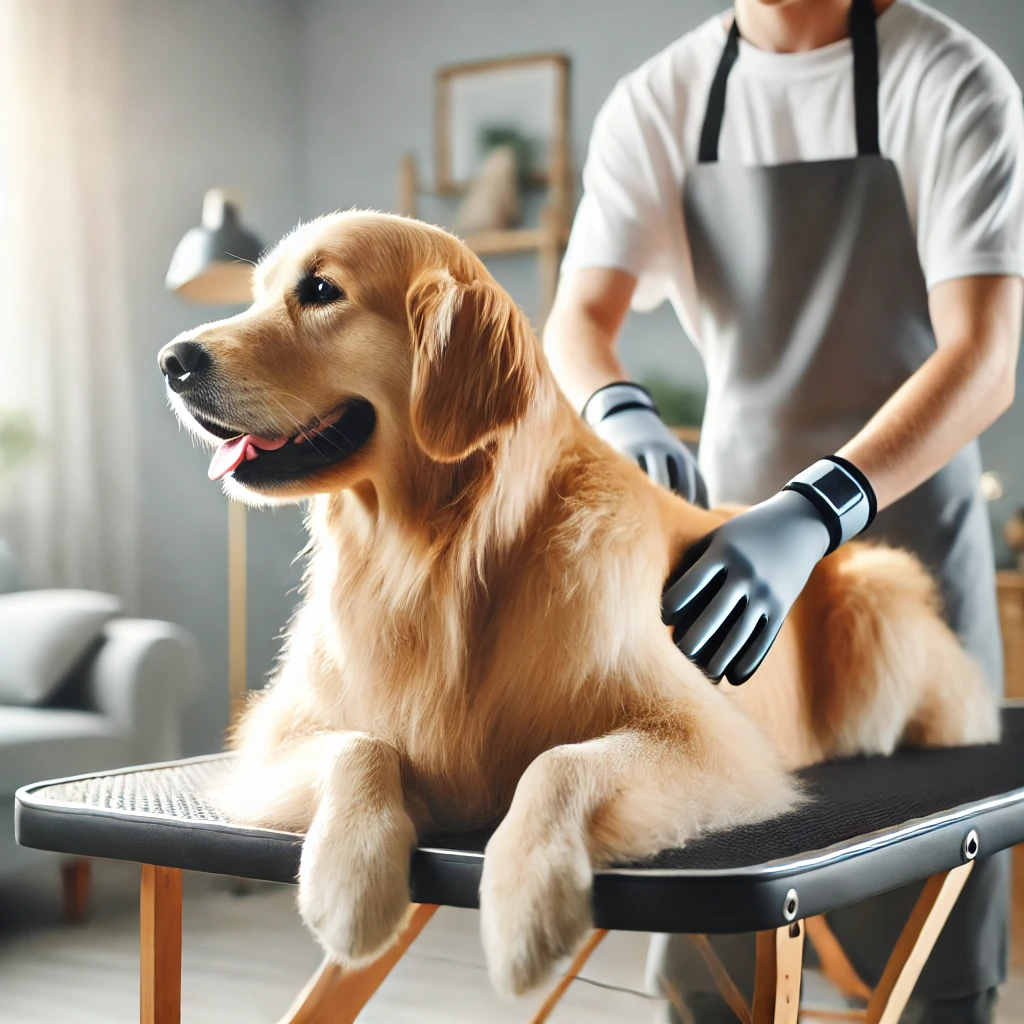Introduction:
The traditional adage “No Hoof, No Horse” is the foundational pillar of equine sports medicine. Furthermore, it forms the basis of both therapeutic and preventive horse hoof care. This phrase is not merely a popular proverb exchanged by equestrians. On the contrary, it is an absolute anatomical and biomechanical truth.
Specifically, it summarizes the total dependency of the horse on this organ. The horse is an animal weighing hundreds of kilograms. It relies on speed and movement for survival and evolution. Therefore, its existence depends on the integrity of this relatively small and extremely complex structure.
The hoof is the sole point of contact between the horse’s massive skeletal structure and the ground surface. Primarily, it is responsible for bearing the immense shock forces generated during high-speed impact. Additionally, it converts kinetic energy. Moreover, it pumps blood returning from the lower limbs. Remarkably, it does this in defiance of the laws of gravity.
Furthermore, it includes soft tissues (vascular and fatty tissues) and very hard tissues (keratinized walls). Any imbalance in this delicate equilibrium can be disastrous. Whether caused by genetic, nutritional, or environmental factors, or even mechanical negligence in horse hoof care, the result is the same. It inevitably leads to the collapse of the horse’s entire locomotor system. Consequently, it transforms the horse from a superior athlete into an incapacitated animal suffering from chronic pain.
This research article offers an extensive and accurate review of all aspects related to the best practices for horse hoof care and health. We rely on the latest scientific studies, microscopic analyses, and advanced veterinary protocols.
We will deeply discuss the microscopic anatomy of the digital cushion and its histological differentiation. Additionally, we will examine complex blood flow dynamics. Furthermore, we will cover the ongoing scientific debate between “barefoot” advocates and traditional farriery schools. Finally, we will arrive at the minute details of diseases such as Canker and Laminitis, including the complex pain management mechanisms associated with them.
Chapter One: Anatomy as the Foundation of Horse Hoof Care
To understand how to approach horse hoof care and treat it correctly, one must first dive into its complex structure. This structure exceeds the hard outer shell. The hoof is a closed box. It contains precise mechanisms for shock absorption and pressure distribution. Therefore, it relies on the interaction between internal and external structures for its function.

1.1 External Structures in Horse Hoof Care
The external hoof, or hoof capsule, is the structure we see with the naked eye. It is what the farrier deals with directly during the horse hoof care routine. It consists primarily of the hoof wall, the sole, and the frog. Each of these possesses unique mechanical properties.
The Hoof Wall
The hoof wall serves as a protective shield. Furthermore, it is the main weight-bearing structure. Chemically, it consists of keratin. This is a hard, insoluble fibrous protein. Notably, it is characterized by strong sulfur bonds that give it both hardness and flexibility simultaneously. Anatomically, the wall is divided into three layers:
- Stratum Externum: This is a thin, shiny layer. It protects the hoof from dehydration and prevents the evaporation of internal moisture.
- Stratum Medium: This is the thickest and hardest layer. It consists of densely packed Horn tubules surrounded by Intertubular horn. This geometric arrangement of tubules gives the wall immense compressive strength. Consequently, it allows the wall to bear the horse’s weight without buckling.
- Stratum Internum: This layer connects to the sensitive laminae. It plays a pivotal role in suspending the coffin bone within the capsule.
The Frog
The frog is the V-shaped flexible structure located in the center of the sole. Its function goes beyond merely filling space. In fact, it is a vital part that must be focused on during horse hoof care to maintain dynamic mechanics.
- Shock Absorption: The frog acts as a flexible cushion. It absorbs part of the impact energy upon contact with the ground.
- Traction: Thanks to its rubbery nature and geometric shape, the frog provides stability for the horse on various surfaces.
- Blood Pump: It plays a fundamental role in activating blood circulation. Specifically, it acts as a piston that compresses the digital cushion to pump blood.
The Sole
The sole is the bottom surface of the hoof. Typically, it is slightly concave to lift sensitive tissues off the direct ground. Unlike the wall, the sole is not designed to bear direct weight continuously. Its primary function is to protect internal structures from bruising and penetration.
However, in flat-footed horses, the sole loses its natural concavity. This exposes it to constant bruising. Furthermore, it negatively affects the health of the digital cushion. As a result, this necessitates special horse hoof care in these cases.
1.2 Internal Structures: The Digital Cushion
The Digital Cushion (DC) is considered one of the most important internal structures. It is currently receiving increasing research attention in modern veterinary medicine. It is a mass of flexible tissue located behind the coffin bone and above the rib cage. Additionally, it contributes to the formation of the heels.
Microscopic Analysis and Histological Differentiation
Recent research highlights a crucial fact. Specifically, a study conducted on Quarter Horses indicates that the digital cushion is not a homogeneous mass of fat or cartilage as previously thought. On the contrary, it is a complex structure. It varies in microscopic structure according to the anatomical region.
In these studies, the digital cushion was divided into four main zones:
- Axial Proximal (AxProx)
- Axial Distal (AxDis)
- Abaxial Lateral (AbxLat)
- Abaxial Medial (AbxMed)
Results showed fundamental structural differences between these zones:
- Axial Distal Zone (AxDis): This zone was distinguished by containing a much larger number of Collagen bundles compared to other zones. Meanwhile, it contained a lower percentage of elastic fibers. This composition points to its function in providing strength and direct structural support under the coffin bone.
- Axial Proximal Zone (AxProx): This zone contained a higher density of Elastic fibers. This gives it the property of Elastic recoil. Furthermore, it provides the ability to store and release energy.
Clinical Importance for Horse Hoof Care
In healthy hooves receiving proper horse hoof care, the digital cushion is a strong and flexible Fibro-cartilaginous tissue. However, in hooves that suffer from functional weakness, this cushion atrophies. It turns into soft “fatty” tissue that lacks the necessary structural elasticity. This pathological transformation is often observed in horses with flat feet or low heels.
1.3 Lateral Cartilages and Their Dynamic Role
The Lateral Cartilages (or Ungual Cartilages) are found on both sides of the coffin bone. They extend upwards above the coronary band. Their function exceeds structural support. It includes regulating hydraulic pressure inside the hoof.
- Pressure Regulation: The cartilages act as flexible resistance to the descent of the coffin bone during the weight-bearing phase.
- Energy Storage: They act as a biological spring. This spring stores potential energy during landing and releases it during propulsion.
1.4 Bones and Joints Within the Hoof
- Coffin Bone (P3): This is the main bone inside the hoof. It has a shape resembling the hoof itself. The sensitive laminae connect to it, suspending the entire hoof. Therefore, the health and position of this bone determine the success of horse hoof care. Any rotation or sinking of it implies an infection with Laminitis.
- Navicular Bone: This is a small bone located behind the joint between the coffin bone and the short pastern bone. It acts as a Pulley. The deep digital flexor tendon passes over it, thus reducing friction.
Chapter Two: Biomechanics and Its Impact on Horse Hoof Care
The hoof is not a static prop. It is a dynamic organ that changes shape and size with every step. Furthermore, it performs a vital function in blood circulation known as the “Second Heart” mechanism. Understanding this biomechanics is essential for applying correct horse hoof care protocols and understanding the causes of lameness.
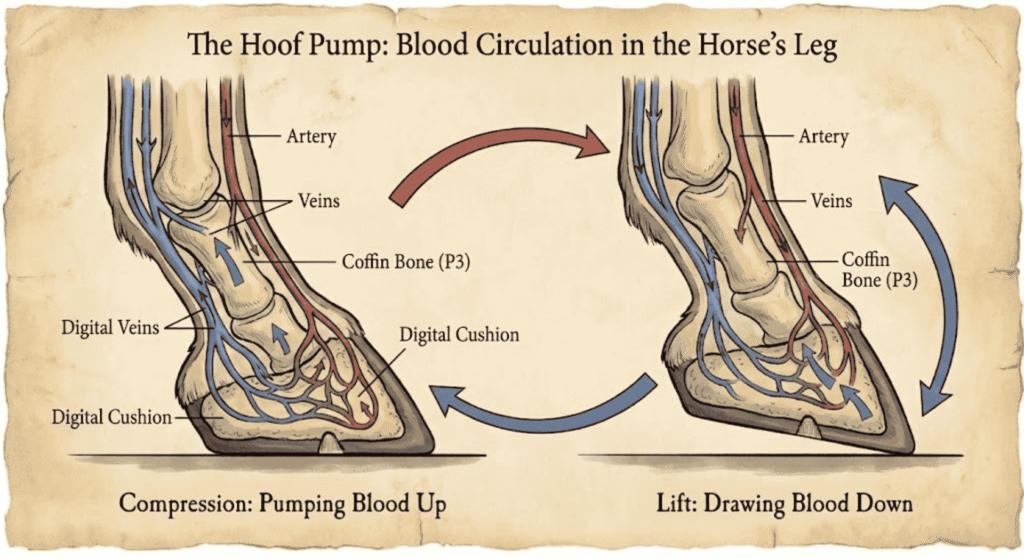
2.1 The Hemodynamic Mechanism
The horse faces a major physiological challenge. It must pump blood from the lower limbs (which are very far from the heart) against gravity. There are no large muscles in the lower leg to do this. Consequently, the horse relies on the “hoof pump.”
Theories Explaining Blood Pumping
There are two main theories explaining how the hoof works as a pump:
- Pressure/Compression Theory: This traditional theory suggests that direct ground pressure on the Frog and digital cushion leads to the expansion of the lateral cartilages. This compresses the dense venous plexus inside the hoof. As a result, it drives blood forcefully upwards toward the leg and heart.
- Depression Theory: Newer theories suggest that the descent of the middle phalanx and coffin bone during weight-bearing causes an outward displacement of the lateral cartilages. This creates a pressure vacuum (alternating negative and positive pressure). This vacuum draws blood in and then pushes it out. According to this theory, the movement of internal bones is the primary driver.
Regardless of the exact theory, the result is the same. Movement is essential for circulation. A horse standing for long periods suffers from blood stagnation in the limbs (Stocking up). Conversely, a moving horse enjoys active blood flow that nourishes tissues and removes toxins. This is what horse hoof care guidelines emphasize.
2.2 Energy Dissipation
During a Gallop, a horse places approximately 2.5 times its total body weight on a single limb. If this immense energy is not dissipated, it will transfer directly to bones and joints. This causes fractures and devastating injuries.
The hoof dissipates this energy through:
- Heel expansion.
- In compression of the digital cushion.
- Elastic deformation of the lateral cartilages.
- Viscoelastic properties of the hoof wall itself.
Studies have shown that the hoof’s ability to dissipate energy is closely linked to its shape and balance. Unbalanced hooves or those suffering from atrophy in posterior structures due to poor horse hoof care (Heel pain/atrophy) fail to dissipate energy efficiently.
2.3 The Effect of Farriery on Biomechanics
Human intervention via Shoeing has profound, and sometimes negative, effects on these natural mechanisms. Therefore, making the choice of shoeing method is a crucial part of horse hoof care.
Hoof Mechanism Restriction
A natural hoof expands upon contact with the ground. Applying a rigid metal shoe and fixing it with nails restricts this natural movement.
- Nail Position: Biomechanical studies have proven that placing nails in the Palmar/Plantar aspect (i.e., behind the quarter) significantly limits heel expansion.
- Consequences: Restricting expansion prevents natural shock absorption. This increases the load on joints and tendons. Additionally, it alters strain distribution on the hoof wall.
High-Frequency Vibrations
Another concerning point is vibration. A metal shoe impacting a hard surface generates vibrations at high frequencies reaching 800 Hz. Some research suggests these vibrations may be harmful to living tissues inside the hoof. Furthermore, they may affect microcirculation.
Chapter Three: Precision Nutrition for Horse Hoof Care
The hoof is a direct product of what the horse eats. Simply put, no external measure within horse hoof care can repair a hoof built with poor raw materials. Nutrition affects growth rate, keratin quality, and disease resistance.
3.1 Biochemistry of Keratin
Keratin is the primary structural protein in the hoof. For high-quality keratin to be synthesized, the body requires a constant supply of specific amino acids and minerals.
Table 1: Essential Nutrients and Their Precise Functions in Horse Hoof Care
| Nutrient | Precise Functional Role | Research Notes |
| Biotin | An enzymatic cofactor in the process of Keratinization. | Recommended therapeutic dose is 15-20 mg/day to achieve noticeable improvement in growth and quality. |
| Methionine | Sulfur-containing amino acid, providing the sulfur needed to form sulfur bonds. | Sulfur bonds give keratin its hardness and physical/chemical resistance. |
| Zinc | Essential for activating the enzyme Thiol oxidase, responsible for forming cross-links. | Deficiency leads to slow growth and increased susceptibility to ulcers and infections. |
| Copper | Essential for activating the enzyme Thiol oxidase responsible for forming cross-links. | Deficiency leads to structural weakness and brittle hooves. |
| Fatty Acids (Omega-3) | Maintaining wall flexibility and forming the Permeability Barrier. | Prevents internal moisture loss and repels external bacteria and fungi. |
3.2 Impact of Nutritional and Metabolic Balance
The relationship between minerals is delicate and sensitive. For example, excess Zinc may lead to lower Copper absorption. Similarly, excess Sulfur may affect Selenium absorption. Therefore, random supplementation can be harmful and hinder proper horse hoof care.
Moreover, the metabolic state of the horse plays a crucial role. Horses suffering from “Equine Metabolic Syndrome” (EMS) or insulin resistance are significantly more prone to chronic laminitis and poor hoof quality.
Chapter Four: Pathology and Therapeutic Horse Hoof Care Protocols
Horse hooves are exposed to a wide range of diseases. Understanding the subtle differences between them is the key to successful treatment. Misdiagnosis, especially between cases of “Thrush” and “Canker,” can lead to disastrous results that hinder horse hoof care efforts.
4.1 Thrush: The Silent Enemy
It is a Necrotizing infection affecting the frog sulci.
- Biological Cause: Anaerobic bacteria, specifically Fusobacterium necrophorum, which thrive in oxygen-free environments.
- Risk Factors: The primary factors are wet and filthy environments (accumulation of manure and urine) resulting from poor horse hoof care and hygiene. Additionally, deep, narrow hooves trap dirt.
- Symptoms: A very foul and distinct odor, sticky black discharge, erosion of frog tissue, and sensitivity during cleaning.
The Treatment Protocol
- Simple Surgical Debridement: This involves removing dead tissue to open the sulci. This exposes the bacteria to oxygen, which kills them.
- Topical Treatment: Using dedicated antiseptics like Iodine or Thrush Buster is essential. Important Warning: Avoid highly caustic substances like concentrated bleach.
- Environmental Modification: Providing a dry, clean footing is an integral part of treatment and the foundation of horse hoof care.
4.2 Canker: The Diagnostic and Therapeutic Challenge
Canker is a nightmare for every veterinarian and horse owner. It is often confused with severe Thrush, which leads to worsening of the condition.
- Pathological Distinction: While Thrush is an “erosive” and necrotizing process, Canker is a Hypertrophic/Proliferative process. This means it involves the thickening and multiplication of tissues.
- Distinct Symptoms: It appears as abnormal tissue growth resembling “Cauliflower-like” structures. It is white or pale yellow in color and bleeds easily.
- Surgical Treatment: The only effective solution is Aggressive Debridement of all affected tissues until healthy tissue is reached. This is followed by Cryotherapy.
Table 2: Fundamental Differences Between Thrush and Canker
| Feature | Thrush | Canker |
| Nature of Disease | Necrotizing (tissue-eating) | Proliferative (excess tissue growth) |
| Appearance | Erosion, black discharge | Cauliflower-like tissue, white/yellowish |
| Response to Astringents | Good, aids in healing | Poor, leads to worsening condition |
| Required Intervention | Cleaning and topical | Surgical and Cryotherapy |
4.3 Hoof Abscess: Sudden Pain
An abscess is the most common cause of Acute Lameness. Usually, it is an indicator of a temporary lapse in preventive horse hoof care.
- Mechanism: Bacteria enter through a tiny crack, a nail hole, or via the white line. The bacteria multiply, producing Pus and gases inside the rigid hoof.
- Diagnosis: Symptoms include severe lameness, a strong Bounding Pulse in the digital artery, heat in the hoof, and a painful response to hoof testers.
- Treatment: The basic principle is “Ubi pus, ibi evacua” (Where there is pus, evacuate it). A passage must be opened to drain the abscess.
4.4 White Line Disease
It is a gradual separation between the hoof wall layers (Stratum medium and Stratum internum). It starts from the Solar surface and moves upwards.
- Radical Treatment: The most effective horse hoof care solution for this condition is Hoof Wall Resection. This involves removing all the detached wall overlying the affected area.
Chapter Five: Laminitis – The Biological Crisis
Laminitis, or “Founder,” is not merely a hoof disease. On the contrary, it is a Systemic disease ending in a catastrophe. It challenges all traditional horse hoof care methods.
5.1 Complex Pathophysiology
The disease occurs when the Hemidesmosomes that bind the Epidermal lamina to the Dermal lamina collapse. This collapse allows the coffin bone to separate from the hoof wall. This happens under the influence of the horse’s weight and the pull of the deep digital flexor tendon.
- Rotation: The tip of the coffin bone rotates downward, pressing on the sole.
- Sinking: The entire coffin bone descends inside the capsule.
5.2 Multi-Pathway Pain Management
Pain in laminitis is severe and complex. It includes:
- Nociceptive Pain: Resulting from mechanical tearing and pressure.
- Inflammatory Pain: Resulting from chemical mediators of inflammation.
- Neuropathic Pain: Resulting from damage to peripheral nerves in the hoof.
5.3 Cryotherapy in Horse Hoof Care
Modern literature shows that continuous cooling of the hoof is critical. This involves covering the hoof and pastern with ice. Using this during the Prodromal stage and the acute stage is the only intervention proven effective in reducing tissue damage.
Chapter Six: Horse Hoof Care Options: Barefoot vs. Shoeing
A heated debate exists in veterinary and sporting circles regarding horse hoof care. Specifically, should a horse remain Barefoot or be shod? Determining the most suitable style depends on a careful assessment of the horse’s needs, environment, and work.
6.1 Barefoot: Back to Nature
- Biomechanical Advantages: Being barefoot allows for full natural heel expansion. This enhances blood circulation (the “Second Heart” mechanism) and shock absorption.
- Health Benefits: Reports from Olympic riders indicate lower rates of injury and lameness when transitioning to barefoot.
- Challenges: It requires a transition period that may be painful for the horse while the sole thickens and internal structures harden. Additionally, it requires precise management of the footing and frequent trimming as part of the horse’s hoof care routine.
6.2 Shoeing: Necessity and Intervention
The horseshoe is not absolute evil. In fact, it is a necessary tool for horse hoof care in certain cases:
- Protection: When the rate of hoof wear is faster than the rate of growth.
- Traction: Shoes containing holes for Studs provide necessary stability for jumping horses.
- Therapy: Some deformities and injuries cannot be treated without mechanical intervention via corrective shoes.
6.3 Therapeutic Farriery
When pharmaceutical medicine fails, “Mechanical Medicine” intervenes via shoes. This is one of the advanced horse hoof care methods.
- Heart Bar Shoe: Used in cases of Laminitis. It works by transferring the load from the painful dorsal hoof wall to the frog and digital cushion.
- Egg Bar Shoe: Increases the weight-bearing surface area behind the heel. It is ideal for horses suffering from navicular syndrome.
- Straight Bar Shoe: Provides stability to the hoof capsule and prevents excessive expansion.
Chapter Seven: Daily Horse Hoof Care Protocols and Sustainable Management
Prevention is the cornerstone of hoof health. A simple daily care routine can prevent costly health disasters.
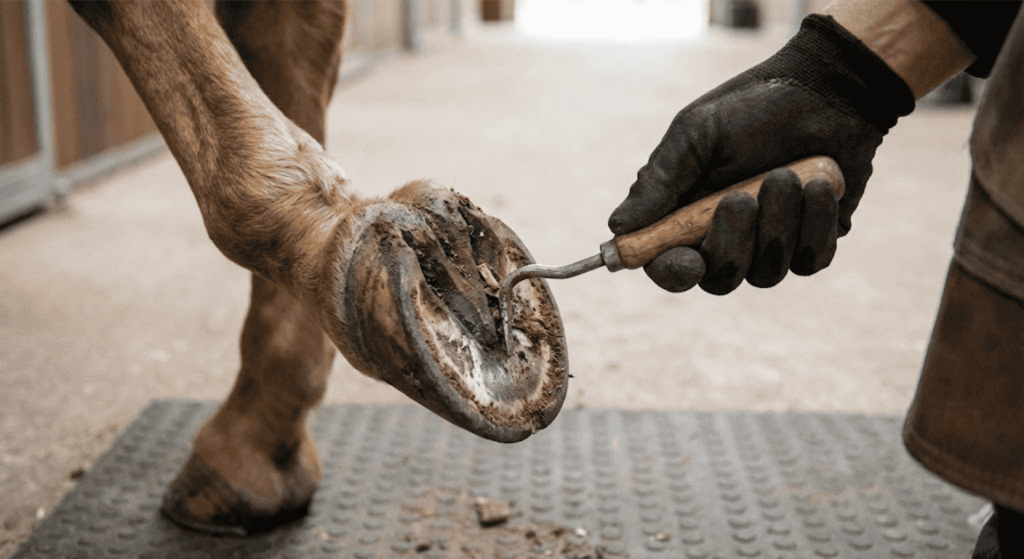
7.1 Daily Cleaning and Inspection
Horse hoof care basics start with hygiene:
- Cleaning (Picking Out): Dirt, manure, and stones must be removed from hooves daily, as well as before and after work. The correct technique involves cleaning from the heel toward the Toe. One must pay strict attention to cleaning the collateral sulci of the frog.
- Sensory Inspection: The owner must learn to feel the hoof temperature by hand daily (to detect sudden heat). Also, they must smell the hoof (to detect Thrush).
7.2 Farrier Schedule
The hoof growth cycle dictates a farrier visit every 6 to 8 weeks. In horses with rapid growth or corrective issues, the interval may decrease to 4-5 weeks. Leaving hooves to grow too long alters hoof angles. This causes mechanical lameness that indicates a failure in preventive horse hoof care.
7.3 Environmental Management
A clean, dry environment is the best treatment for hooves. Standing in mud and urine leads to softening of the horn. This makes it permeable to bacteria. Consequently, using dry Bedding and removing wet spots significantly reduces the risk of Thrush and abscesses.
Conclusion
In concluding this extensive article, it becomes abundantly clear that the hoof is not merely a peripheral part of the horse. It is a mirror of the animal’s general health, diet, and environment. Furthermore, it reflects the quality of horse hoof care it receives.
From the microscopic structure of the digital cushion to the complex mechanics of therapeutic shoeing, every detail plays a role. These details keep the horse sound and athletic.
Combining accurate scientific knowledge (anatomy and physiology) with daily practical practice (cleaning, nutrition, qualified farrier) is the only way to success. This achieves the meaning of the timeless saying: “No Hoof… No Horse.”
Ignoring any pillar of this system will have consequences. Whether it is neglecting frog cleaning, poor nutrition, or bad shoeing, the price will be paid. The horse will pay with its health, performance, and welfare.

